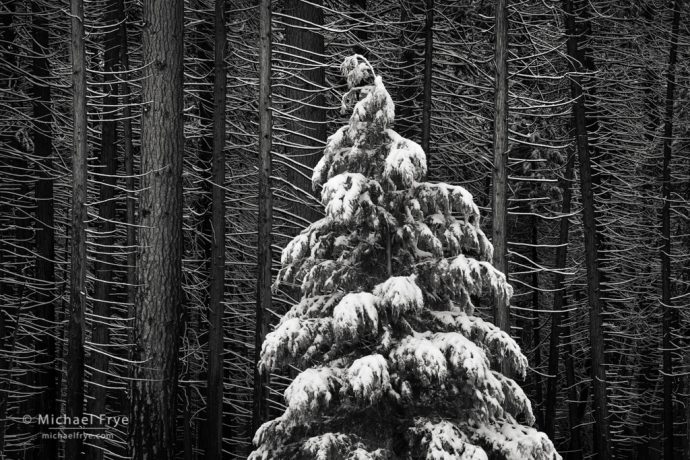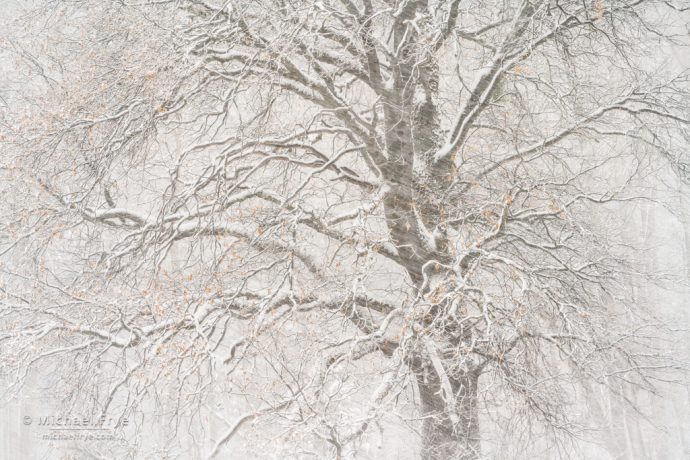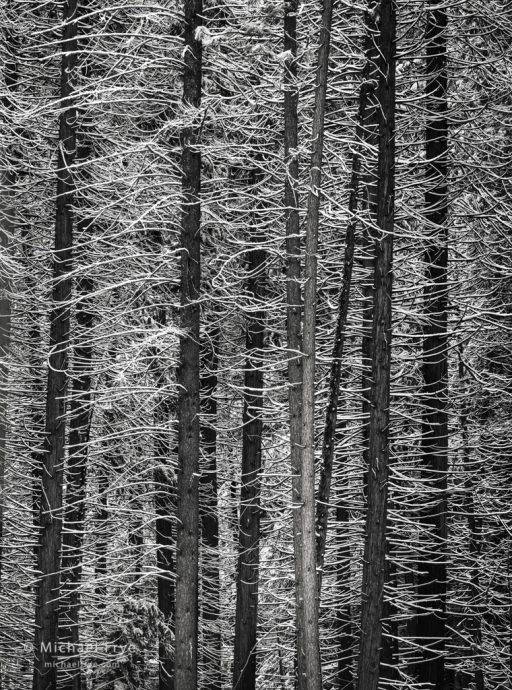In my last post I described how the most recent snowstorm led to some beautiful light and clouds – especially late in the day.
But when I arrived in the valley that morning it was still snowing. So I did what I always do: I asked myself, “What’s happening now?” In other words, what was interesting or unusual about that moment? What was unique and special in this place I’ve photographed so many times before?
The obvious answer was the snow. Not just snow on the ground, or in the trees, but snow still falling from the sky. I knew from past experience that falling snow could give images a soft, fog-like appearance, which often works well with trees.
So I started thinking about individual trees or stands of trees that might look interesting under those conditions. And it occurred to me that I’d never photographed one of my favorite oaks in a snowstorm before. So I decided to try it.
The beautifully-shaped, spreading branches of this tree stood out nicely, forming dark shapes against the white snow. And a few leaves still clung to its branches, creating tiny splotches of color amid all the grays and whites.
I tried different shutter speeds. Fast shutter speeds (1/125 sec. and up) created tiny dot patterns, reminiscent of pointillist paintings. Slower shutter speeds, like 1/15 sec. or 1/30 sec., turned the falling snowflakes into streaks. These slower shutter speeds work better when wind turns the streaks into diagonal lines, as happened on that morning, so I ended up liking the slower shutter speeds better (as shown in the photograph at the top of this post).
Later, after the snow stopped, I photographed the late-morning clearing storm. Then the clouds and mist dissipated, leaving mostly blue skies overhead. What was happening then that was unique and interesting? Well there was still snow on the trees. I noticed some snow-covered branches with myriads of tiny, horizontal lines. I love patterns like this, so I spent an enjoyable half an hour exploring different compositions of those trees.
The term “landscape photography” is something of a misnomer. We don’t photograph landscapes; we photograph light. And the appearance of a landscape – the light that we’re actually photographing – shifts from minute to minute, and day to day, as the sun moves, and the weather and seasons change.
If you view the landscape as static and immutable, you might miss some wonderful opportunities. But if you tune in to the changes – if you ask yourself what’s happening now that’s interesting or unusual – you might find unique and beautiful moments, even in a place you’ve photographed many times before.
— Michael Frye

Young incense cedar among old incense cedars and ponderosa pines, Yosemite. 104mm, 1/20 sec. at f/16, ISO 100, focus-stacked.
Related Posts: Drawing With Light; What’s Happening Now
Michael Frye is a professional photographer specializing in landscapes and nature. He is the author or principal photographer of The Photographer’s Guide to Yosemite, Yosemite Meditations, Yosemite Meditations for Women, Yosemite Meditations for Adventurers, and Digital Landscape Photography: In the Footsteps of Ansel Adams and the Great Masters. He has also written three eBooks: Light & Land: Landscapes in the Digital Darkroom, Exposure for Outdoor Photography, and Landscapes in Lightroom: The Essential Step-by-Step Guide. Michael has written numerous magazine articles on the art and technique of photography, and his images have been published in over thirty countries around the world. Michael has lived either in or near Yosemite National Park since 1983, currently residing just outside the park in Mariposa, California.











There are times when I arrive in Grand Teton National Park (I’m over the mountain in Victor) and wonder, “I thought I was going to see some photographic weather.” But I’m going to have to follow a much better lead and ask myself, “What’s happening now?” Reading your blogs and seeing the great photo (many of which are “unusual”) are certainly motivating. I need to “tune in to the changes” I can teach myself (from learning from a mentor) to find unique and beautiful moments. Going “up-close” can make it “and personal.” Thanks Michael.
Glad you found this helpful Randy!